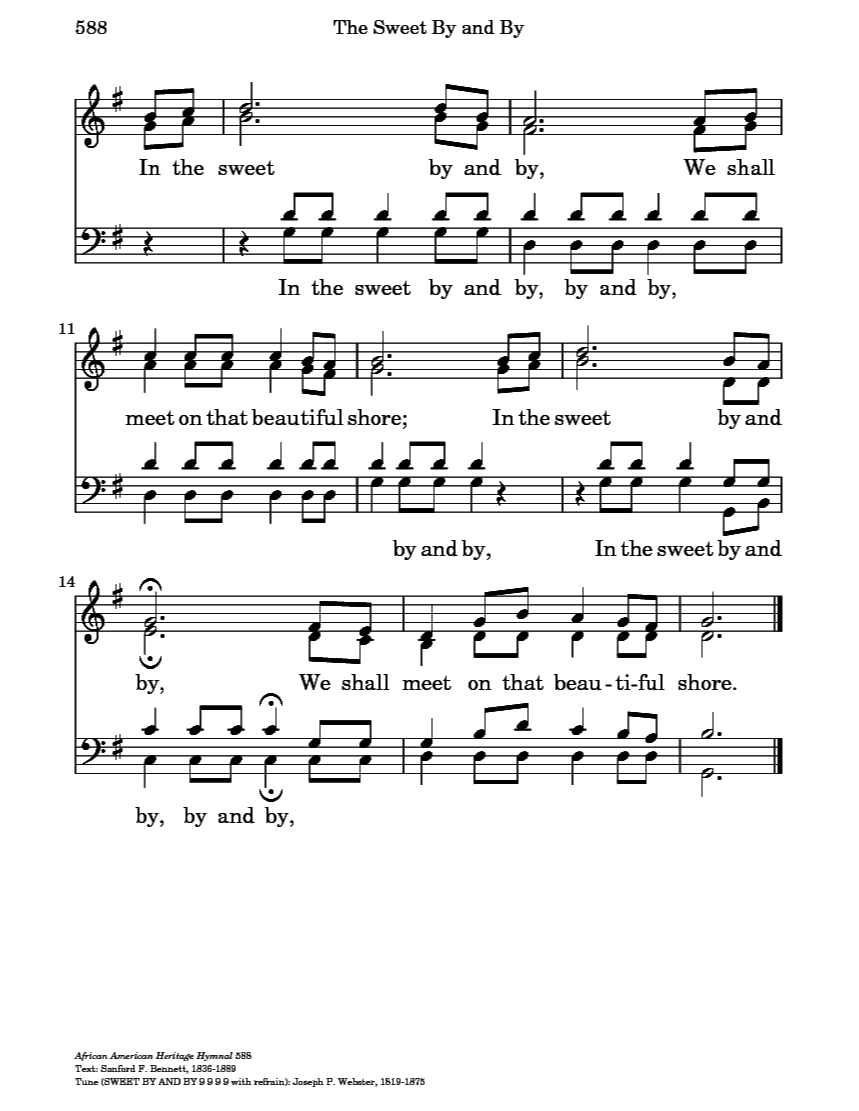|
Hi, The song of the week will be 'In The Sweet By And By' in the key of G. Sacred songs, in many cases taken directly from old Baptist, Methodist, and Presbyterian hymnals, occupy a prominent place in the Bluegrass music tradition. They make up one of the largest single categories of songs in the genre. It is common for Bluegrass bands at all levels (ranging all the way from hobby bands to top-notch professional touring bands) to record entire albums consisting of nothing but sacred songs, and many of the biggest names in Bluegrass have recorded several of these. There are even some Bluegrass bands that specialize in 'Bluegrass Gospel' to the total, or almost total, exclusion of other categories of songs. (The very first hobby Bluegrass band that I was part of when I was in my early teens was one of those types of bands.) Most of the bands that I played with during my teen years, in doing the Summer Bluegrass festival circuit in BC, needed to have at least 45 minutes worth of this type of material in their repertoire, so that they would be able to play a Bluegrass Gospel set when scheduled to perform on a Sunday morning at a festival. Many of the first-generation Bluegrass pioneers learned the fundamentals of music, including how to sing, in church. It was therefore quite natural that they would adapt some of the songs they knew from church to the new genre of music they were creating. I associate 'In The Sweet By And By' with weekend afternoon jams with friends, late night jams around campfires at Bluegrass festivals, and impromptu live performances much more so than with any particular studio recording of the song by a well-known Bluegrass artist. For that reason, the first youtube link I present below is that of such an impromptu live performance of the song. Slope Valley and Palmetto Blue: Key of G: https://www.youtube.com/watch?v=DEE0EXC8GYI&feature=youtu.be Notice that on the last 2 choruses the lead singer drops down to the baritone harmony part. This part is quite audible and straightforward (no unusual note choices) and therefore a good place to learn the baritone harmony from. I have also included in the attachments ('03 Track 3') a recording (from 2006) of 'In The Sweet By And By' (key of D) that I played banjo on, in which the band consisted of people that I used to jam with at Bluegrass festivals. In accord with the wishes of the leader of the band 'String Lizzy' (who kicks off the song on the mandolin at a somewhat faster tempo than what the song is customarily played at - but the tempo choice is well-suited to her straightforward playing and singing style - and sings lead on the song, and mostly in German), we recorded the album by standing in a circle around a few mics in the middle of the circle, to make it feel as much like a jam as what is possible in a recording studio session. Many of the songs that ended up on the album were done in just one take. Notice the similarities in the vocal arrangement on the first youtube link with the following non-bluegrass arrangement ('call and response' arrangement for the chorus, for instance) that is along the lines of the type of church singing that most of the first-generation Bluegrass artists were familiar with from their childhood: Primitive Baptist accapella arrangement: https://www.youtube.com/watch?v=w6d9IkgBSMs In addition to my own handwritten melody sheets for the song in the attachments, here is a link to sheet music from a hymnal that shows three harmony parts together with the melody. The melody is the higher of the pairs of notes that are on the top staff (written with the treble clef); what we call the baritone harmony in Bluegrass is the lower of the pairs of notes on that staff. (If you have a really high voice for Bluegrass, you may raise each of these lower notes an octave higher to create what is called the 'high baritone' part.) The higher part on the bottom staff (written with the bass clef) is what we call the tenor, or the low tenor in Bluegrass depending on whether one sings it in the octave that makes it higher or lower than the melody; and the lower part on that same staff is the bass harmony part. If you are not familiar with reading music written with the bass clef, move each note the equivalent of one line/space higher on the staff so that it can be read as if written with the treble clef, and then, if desired, drop each note an octave lower. Although we will only play breaks over the verse progression, I have written out both the verse and the chorus melodies in the attachments. The song has such a strong melody and I find it quite satisfying to play as an instrumental banjo, mandolin, or guitar tune in which my playing stays very close to the melody, embellished by little more than slides and hammer-ons into the most important melody notes, rolls ( on banjo) or crosspicking (on guitar) around the melody, or double stops (on mandolin and guitar) to harmonize certain parts of the melody. I thought that perhaps some of you would like to have the chorus melody included on the melody sheets for the same reason. Finally, here is a good professional bluegrass studio recording of 'In The Sweet By And By': Bluegrass Martins: key of C https://www.youtube.com/watch?v=UQoWCd3S64k Jason In The Sweet - Mandolin tab
Download File In The Sweet - Banjo tab Download File In The Sweet - Guitar tab Download File In The Sweet - Melody in G Download File
0 Comments
|
Jason's Beginner Jam Blog 2017 - 2018
Songs regularly called at the Beginner Bluegrass Jam and links from Jason's "Song of the Week" emails. (from Renee)
Songs
All
in alphabetical order
|



 RSS Feed
RSS Feed